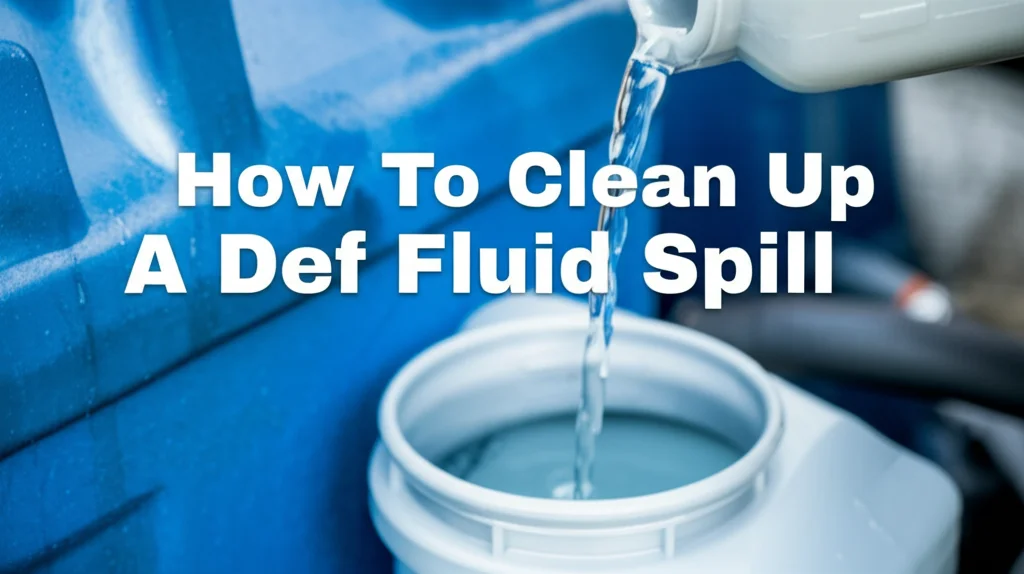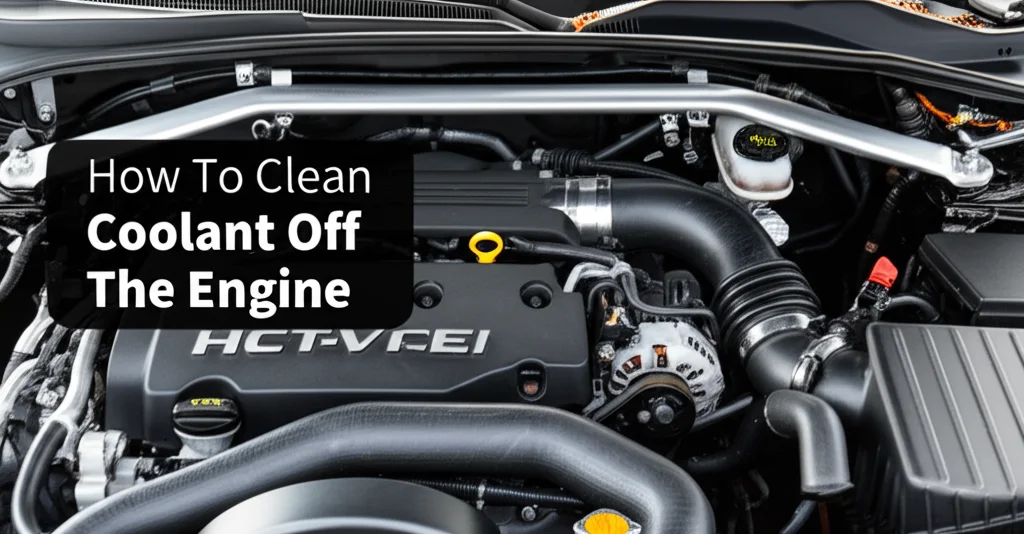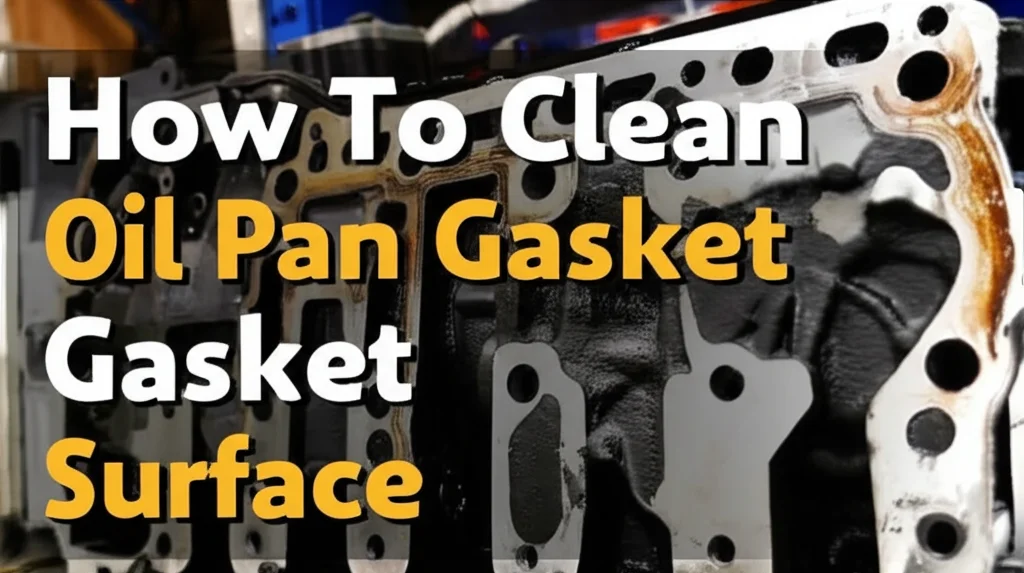· Auto Maintenance · 7 min read
How To Clean Up A Def Fluid Spill

Dealing with a Mess: How To Clean Up A DEF Fluid Spill
Have you recently experienced a DEF (Diesel Exhaust Fluid) spill? Don’t panic! While it might seem daunting, cleaning up DEF fluid is manageable with the right knowledge and a few simple steps. DEF fluid is a crucial component in modern diesel vehicles, reducing harmful emissions, but it can be corrosive and requires careful handling. This article will guide you through everything you need to know to safely and effectively clean up a DEF fluid spill, protecting your vehicle, your property, and the environment. We’ll cover what DEF is, the dangers of a spill, the necessary supplies, and a step-by-step cleanup process.
Takeaway:
- Immediately contain the spill to prevent it from spreading.
- Use absorbent materials like paper towels or kitty litter to soak up the fluid.
- Rinse the area thoroughly with water.
- Avoid using harsh chemicals that could react with the DEF.
- Dispose of contaminated materials properly.
What is DEF and Why Does a Spill Matter?
Diesel Exhaust Fluid is a non-toxic solution of urea and deionized water. It’s used in Selective Catalytic Reduction (SCR) systems to reduce nitrogen oxide emissions from diesel engines. However, DEF fluid can become corrosive when exposed to air and moisture, especially on certain surfaces. A DEF spill isn’t just about the sticky mess; it can damage paint, corrode metal, and potentially harm landscaping. Quick and proper cleanup is essential to minimize these risks.
Immediate Action: Containing the DEF Fluid Spill
The first few moments after a DEF fluid spill are critical. Your immediate goal is to prevent the spill from spreading and causing further damage. Think fast and act quickly! Here’s what you should do right away:
- Stop the Source: If the spill is from a leaking container or vehicle component, immediately stop the leak. Tighten caps, reposition containers, or address the source of the leak.
- Contain the Spill: Use absorbent materials like paper towels, rags, or even kitty litter to create a barrier around the spill. This will prevent it from flowing into drains, onto landscaping, or across larger areas.
- Ventilate the Area: If the spill occurred indoors, open windows and doors to provide ventilation. While DEF fluid isn’t inherently toxic, good ventilation is always a good practice.
- Protect Yourself: Wear gloves and eye protection to avoid direct contact with the fluid. While not highly dangerous, DEF can be irritating to skin and eyes.
Gathering Your Supplies for DEF Fluid Cleanup
Before you start cleaning, gather all the necessary supplies. Having everything on hand will make the process smoother and more efficient. Here’s a checklist:
- Absorbent Materials: Plenty of paper towels, rags, or kitty litter. Kitty litter is particularly effective at absorbing large spills.
- Water: A hose or bucket of clean water for rinsing.
- Spray Bottle: For applying water to the affected area.
- Gloves: To protect your hands from direct contact.
- Eye Protection: Safety glasses or goggles.
- Plastic Bags or Containers: For disposing of contaminated materials.
- Neutralizing Solution (Optional): A mild acidic solution like diluted vinegar can help neutralize any remaining DEF residue. (Test in an inconspicuous area first!)
- Cleaning Brush: A soft-bristled brush can help loosen residue.
Step-by-Step: Cleaning Up the DEF Fluid
Now that you’ve contained the spill and gathered your supplies, it’s time to start cleaning. Follow these steps for a thorough and effective cleanup:
- Absorb the Fluid: Generously apply absorbent materials (paper towels, rags, or kitty litter) to the spill. Allow the materials to soak up as much fluid as possible.
- Remove Contaminated Materials: Carefully collect the saturated absorbent materials and place them in plastic bags or containers for proper disposal.
- Rinse the Area: Thoroughly rinse the affected area with clean water. Use a spray bottle or hose to apply the water, ensuring you reach all contaminated surfaces.
- Scrub (If Necessary): If there’s any remaining residue, use a soft-bristled brush to gently scrub the area. Avoid using abrasive cleaners or brushes, as they could damage the surface.
- Neutralize (Optional): If you choose to use a neutralizing solution, dilute vinegar with water (a 1:1 ratio is a good starting point). Test the solution in an inconspicuous area first to ensure it doesn’t damage the surface. Apply the solution, let it sit for a few minutes, and then rinse thoroughly with water.
- Repeat if Needed: If the spill was large or the residue is stubborn, repeat the rinsing and scrubbing steps until the area is clean.
Cleaning DEF Fluid from Different Surfaces
The cleanup process can vary slightly depending on the surface affected by the spill. Here’s a guide for common surfaces:
- Painted Surfaces: Rinse immediately with plenty of water. If the paint is damaged, consider a touch-up repair. You can find more information on paint repair at https://www.beacleaner.com/how-to-clean-waterproof-laminate-floors/.
- Metal Surfaces: Rinse thoroughly with water and check for signs of corrosion. If corrosion occurs, consider applying a rust inhibitor.
- Concrete: Kitty litter is excellent for absorbing DEF fluid on concrete. Rinse thoroughly with water afterward.
- Plastic: Rinse with water and mild soap. Avoid harsh chemicals that could damage the plastic.
- Fabric/Upholstery: Blot up as much fluid as possible with paper towels. Then, clean the area with a fabric cleaner designed for automotive use.
Proper Disposal of DEF Fluid and Contaminated Materials
Proper disposal is crucial to protect the environment. Never pour DEF fluid down the drain or into the ground. Here’s how to dispose of DEF fluid and contaminated materials correctly:
- Contaminated Absorbent Materials: Place the used paper towels, rags, or kitty litter in sealed plastic bags and dispose of them according to your local regulations. Some areas may allow you to dispose of them with regular trash, while others may require you to take them to a hazardous waste facility.
- Unused DEF Fluid: If you have unused DEF fluid that’s been contaminated, contact your local hazardous waste facility for disposal instructions.
- Check Local Regulations: Always check your local regulations for specific guidelines on disposing of DEF fluid and contaminated materials.
Preventing Future DEF Fluid Spills
Prevention is always better than cure. Here are a few tips to help prevent future DEF fluid spills:
- Handle with Care: Be careful when handling DEF fluid containers. Avoid dropping or tipping them.
- Secure Containers: Ensure DEF fluid containers are securely closed and stored in a stable location.
- Use a Funnel: When filling your vehicle’s DEF tank, use a funnel to prevent spills.
- Regular Inspections: Regularly inspect your vehicle’s DEF system for leaks.
- Proper Storage: Store DEF fluid in a cool, dry place away from direct sunlight.
FAQ: Your DEF Spill Questions Answered
Q: Is DEF fluid toxic?
A: DEF fluid is generally considered non-toxic to humans and animals, but it can be irritating to skin and eyes. Direct contact should be avoided, and spills should be cleaned up promptly to prevent corrosion.
Q: Can I use bleach to clean up a DEF spill?
A: No, do not use bleach or other harsh chemicals to clean up a DEF spill. These chemicals can react with the DEF fluid and create harmful fumes. Stick to water and mild, neutral cleaning solutions.
Q: What if DEF fluid gets on my car’s paint?
A: Rinse the area immediately with plenty of water. If the paint is damaged, consider a touch-up repair. Prolonged exposure can cause paint damage.
Q: How do I know if my DEF tank is leaking?
A: Look for visible fluid under your vehicle near the DEF tank. You may also notice a DEF fluid odor. If you suspect a leak, have your vehicle inspected by a qualified mechanic.
Q: Can I dilute DEF fluid with water?
A: No, diluting DEF fluid with water will alter its chemical composition and render it ineffective. Always use undiluted DEF fluid in your vehicle’s SCR system.
In conclusion, cleaning up a DEF fluid spill doesn’t have to be a stressful experience. By following these steps – containing the spill, gathering the right supplies, cleaning thoroughly, and disposing of materials properly – you can minimize damage and protect your vehicle and the environment. Remember, prompt action and careful handling are key. If you’re dealing with a particularly large or difficult spill, don’t hesitate to consult a professional cleaning service. You can also find helpful information on maintaining your vehicle’s overall cleanliness at https://www.beacleaner.com/how-to-clean-hardwood-floors-with-vinegar/.




